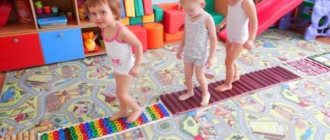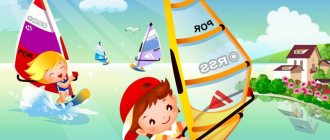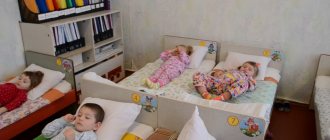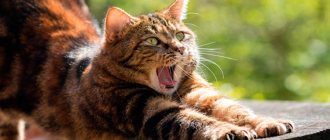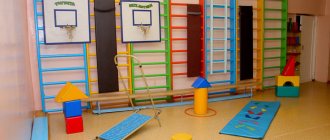Name of exercises Description “Stretches” Lying down, while inhaling, stretch your arms up and your legs forward as hard as you can. “Mosquito” Starting position - on your back, clap your straight arms in front of you, “catching” the mosquito. “Balls” Jumping near the bed. “Big - small” Starting position - standing. On the word “big” (count “one”) the child straightens up to his full height, on “small” (count “two”) he squats and shrinks into a ball. “Kolobok” Lying on the bed, turn the body to the left and then to the right. “ Kitty - dog "Starting position - on all fours. For the word “cat”, arch your back. When pronouncing “doggy” - bend over (you can wag your “tail” - legs crossed behind you). “Bicycle” Performed mainly in the summer. Lying on their backs, kids pretend to ride a bicycle with their feet. “Monkeys” Starting position - on your back, arms bent at the elbows and pressed to the chest. Alternately straighten one or the other arm, “plucking” bananas from an imaginary tree. “Bathing on the beach” Lying on your back, bend your legs alternately towards your chest.
Exercises in bed and music-rhythm block
The most common combination in awakening gymnastics is poetry, music and the exercises themselves.
Musical-rhythmic block of awakening gymnastics
Here is one of the complexes that can be carried out without lifting the baby from the bed:
- “Stretch” (stretch for 5-10 seconds);
- “Komarik” (clap 5-10 times);
- “Bicycle” (performs for 10-15 seconds);
- “Musicians” (performed to the rhyme):
“We played the harmonica and clapped our hands (the kids clap several times);
Legs - top! top! (stomp on the bed);
Hands - clap! clap! (clap in front of themselves);
And we lower our palms (relax, stretch our arms along the body).
An example of a summary of gymnastics in the second junior group
Usually, the teacher’s notes indicate a thematic complex built on a specific plot.
On a note! It is necessary for children to get used to the method of waking up, so it is recommended to change the complexes no more than 2 times a month.
For example: “The sun is visiting.”
Introduction: “Guys, while you were sleeping, a little sunbeam came to visit us. Look, it’s right in front of your eyes—close your eyes quickly! And now on your nose, on your cheeks, on your neck - stroke yourself with your palms, try to catch it. He is not being naughty, he really wants to play with you. Get up quickly!”
For greater interest, it is recommended to perform to music familiar to children (for example, the song “I’m Lying in the Sun”).
- Exercise 1: “The sun is smiling.” Starting position: standing straight, feet slightly narrower than shoulder width. At the same time raise your right hand, palm up, and your right leg. Place in original position. The same with the left leg and left arm.
- 2nd exercise: “Let's spin with the sun.” I. p. - sitting, knees pulled towards you. On command, finely moving your legs, spin around your axis. Repeat no more than 5 times.
- 3rd exercise: “Sunbathing in the sun.” Lie down in bed, stretch out and roll over onto your stomach, then back onto your back. Hold in each position for 10-15 seconds.
A correctly selected complex in kindergarten teaches the baby to wake up quickly and with a smile on his face, and returns him to active activities in the afternoon. For children in the younger group, a playful approach and the thematic component of awakening exercises are extremely important.
Editor: Elizaveta Sergeevna Koneva
Primary school teacher of the first qualification category, defectologist.
Preview:
Summary of gymnastics after sleep for children of the younger group
Duration: 7 min.
Venue: bedroom, group
Teacher preparation: learn the notes, think about the placement of children and equipment, check the equipment, create a hygienic environment.
Children sleep in T-shirts and panties.
Goal: to help children move from sleep to wakefulness
Objectives: gradual awakening of the body to the upcoming activity, raising muscle tone, preventing postural disorders and flat feet, hardening.
Warm up in bed
The sound of calm music, the children wake up.
Exercises in bed:
I. p.: lying on your back. B: hands up, stretch, lower your hands, say: “Wow!”
The composition “The Lonely Shepherd” by Paul Moria is played.
The teacher says in a quiet voice:
On the pillow, on the sheet
Are pink backs tender?
A clear day has come a long time ago
And knocking on our window!
Guys, do you know who came to you while you were sleeping? Our little fox sister has come to visit us! And she really wants us to play with her today.
A fox lives in the forest,
Hands, legs, cheeks, ears love stretching.
We will stretch lightly and wake up slowly.
And now everyone “Stretched and woke up.”
They raised their straight arms together, stretched, then lowered their arms, saying: “Wow!”
I.p. lying down, arms along the body
B: raise your arms up, turn your hands “flashlights”
We conduct awakening gymnastics in the second junior group
The importance of sleep for the full development of a child is difficult to overestimate. But proper awakening is also very important so that the baby spends the rest of the day in a good mood, which means he is active and cheerful. Children of the second youngest group, due to age characteristics, have a rather difficult transition from a state of rest to physical activity. The teacher faces the difficult task of choosing a suitable set of exercises and combining physical activity.
Definition of the concept of “gymnastics after sleep”
Gymnastics after a nap is a set of exercises that organizes a leisurely transition from the calmness of sleep to continued activity, which is carried out to the accompaniment of rhymes and slow, quiet music. For children of the second youngest group, that is, 3–4 years old, the complex should be in the nature of a game with a plot, where a familiar character acts, who is a model for repeating all actions after him.
Physical activity is distributed in such a way that the complex includes exercises:
- to perform while lying in bed (stretching, swinging legs and arms);
- active block (running, squats, as well as elements of gymnastics for fingers, etc.);
- for the development and improvement of the respiratory system.
The total time to complete the exercises is 5–7 minutes.
It is worth noting that the selection also depends on the overall strategy of the educational program of the preschool institution. So, if hardening groups are practiced in kindergarten, then children do most of the exercises outdoors at any time of the year.
How the baby wakes up determines his mood and physical condition for the rest of the day.
Goals of exercise after sleep
Like all program elements of working with children in kindergarten, the main goal of conducting classes is to preserve and strengthen health. In this context, the goals of post-sleep exercise are:
- tone muscles;
- improve mood;
- prevent curvature of the spine, development of flat feet;
- instill in children the habit of stretching after sleep.
It is important to note that during exercises after sleep there should be no sudden body movements, otherwise muscle strain, increased excitability and dizziness cannot be avoided. In the second younger group, the emphasis is on walking on toes barefoot, as well as lifting.
Types of awakening gymnastics
Typically, educators try to create a complex that is aimed at achieving all the goals of the warm-up. But the educational plans of many kindergartens include only certain types of gymnastics aimed at solving a specific problem. In this case, planning is done for a month. In other words, for example, September - children do warm-up in their cribs, self-massage; October - work on exercise machines or in a hall with sports equipment, etc. We can distinguish such types of invigorating gymnastics as:
- exercises in bed;
- games;
- exercises using simulators;
- jogging on massage mats;
Massage mats are the most popular exercise equipment for awakening gymnastics
What is gymnastics after sleep in kindergarten
The definition according to the Federal State Educational Standard of awakening gymnastics, which is carried out for the younger 2nd group of kindergarten, is a complex consisting of exercises that allow the child to gradually move from measured sleep to active activity. Held to the accompaniment of smooth music.
Gymnastics in bed
Important! For younger preschoolers, the set of exercises should always include a plot character, after whom they “repeat” the actions.
Goals and objectives of gymnastics after sleep
Goals of the awakening complex:
- Improving the baby's mood;
- Prevention of flat feet and curvature of the spine;
- Fostering a culture of awakening among preschool children;
- Toning the muscles of the whole body.
Gymnastics mainly performs a health-improving task, namely: maintaining and strengthening the child’s health.
Conducting thematic sets of exercises solves the educational problem and allows children to develop their motor skills and speech in a playful way.
Rules
- When choosing a set of exercises, you should take into account those activities that occurred before sleep. So, if before lunch there was a role-playing game, then gymnastics may include more intense physical activity.
- The temperature in the bedroom should not be lower than 16–18 degrees.
- For babies who wake up earlier, it is worth preparing several exercises for self-massage, for example, with massage balls.
- Uniform: shorts and T-shirt. Typically, shoes are not required to perform the exercises. The only exceptions are dance elements that require Czech shoes or socks.
- Children cannot be forced to do gymnastics. All babies are different, which means that each one has their own characteristics of awakening. So you just need to find out the reasons for the refusal, but without insisting.
If a child does not want to do an exercise in a group, you should not punish or force, but find out the reason
In order for children to maintain a positive emotional attitude, you need to adhere to time limits.
- Exercises in bed - 1.5–2 minutes.
- Active block loads and breathing exercises - 2-3 minutes.
- Hardening procedures, if any - 3 minutes.
Card file of awakening gymnastics
As already noted, you can achieve the goals determined by invigorating gymnastics by alternating with a combination of different types of gymnastics (usually after half a month). For the second younger group, it is rational to use a combination of two or three types, since in this case it is easier to create a single plot for the entire set - that is, to satisfy the main requirement for carrying out such health-improving work: putting physical activity in the form of a game. Combinations of exercises are compiled in accordance with the planning of work with children of a particular group.
Exercises in bed and music-rhythm block
The most common type of combinations: gymnastics, poetry and music. Let us give an example of several complexes of such gymnastics.
- Exercise "Stretching". Lying on your back, stretch your arms along your body.
- We inhale and at the same time stretch our arms up and our heels forward.
- We return to the starting position and exhale.
- Lying on your back, spread your arms to the sides.
- Lying on your back, bend your knees.
- We play the harmonica and clap our hands loudly. (Children clap).
- Legs up! Top, top! (Children stomp).
Instructions for general developmental exercises and self-massage:
- We lie down on our backs.
- We turn our heads to the right, to the left.
- We stroke the arms, tummy, legs, heels.
- We bend our legs, clasp our knees with our hands and gradually straighten our legs.
This is interesting. Combinations of different types have one feature: the first in these sets will be exercises in bed.
Poem for exercise in bed with elements of gymnastics for the respiratory system.
- A bird sat on the window, a cat meowed in the yard - they decided to wake us up. All! Quiet hour is over!
- Wake up, children, I want to invite you to play hide and seek. (Children lie down on top of blankets. Calm music plays. Children perform movements according to the text).
- Our sleepy palms Woke up little by little, Played hide and seek merrily - Fingers clenched into fists.
- The little toes on our feet know all the paths in the park. They check where the heels are, And play hide and seek with us.
- We almost woke up, our hands stretched out, waved over the sheet, and hid behind the back together.
- We will clasp our hands together in a “lock” above our heads. We will bring our right and left elbows together in front of us. Their knees don’t want to sleep, It’s high time they got up.
- We stuck out our knees and quickly straightened our legs. Our mouths are silent, We train our tongue: We will hide it and show it. "Good afternoon!" - we will say it loudly.
- Let's breathe deeply and blow out the air noisily. Our noses woke up, We smiled at each other! (stand on the mats next to the crib).
Instructions for the exercise “Grow Big”:
- We stand on the mats, lower our arms along the body.
- We place our feet at shoulder level.
Walking on massage mats is very useful for preventing flat feet
Types of awakening gymnastics
Different types of gymnastics are designed to solve specific problems. That's why wake-up exercises are so often planned weeks in advance. For example, in the first complex, children warm up exclusively in their beds. The second complex includes active types of exercises, such as jumping and squats.
Types of awakening gymnastics:
- Breathing exercises;
- Musical and rhythmic classes;
- Corrective exercises and complexes (preventing flat feet (walking on mats with different surfaces) or diseases (hardening));
- Exercises with equipment (hoops, balls, etc.);
- Role-playing games;
- Warm up in bed.
In summer, it is recommended to do gymnastics outside in sneakers or Czech shoes. A light warm-up in this case includes running, jumping, squats, walking on massage surfaces and hardening.
Additional Information! All the necessary exercises can be taken from the book by L. I. Penzulaeva “Physical training (for children 3-4 years old).”
Kindergarten program for developing attention
Varieties of awakening gymnastics
Summary of gymnastics in the second junior group, author Ershova Irina
Typically, educators use complexes that have a plot basis:
- Educator: “Children, it was interesting to watch you while you were sleeping. Some were snoring like a little kitten, some were stretching in their sleep like a little fox, some were buried in the pillow like a little bear cub. Let’s now use our exercises to depict some animals.”
- Gymnastics complex. "The animals have woken up." I. p. - lying on your back, arms along the body. Yawn and stretch well. Repeat several times; the pace is slow.
- Educator. Guess the riddle: An angry, hungry man walks in the forest in the cold winter. He clicks his teeth! This is gray... (wolf)
- "Welcome to the wolf cubs." I. p. - lying on your back, arms along the body. Bring your hands to your chest, then stretch them forward. Return to i. p. Repeat five times; the pace is moderate.
- "Owl". I. p. - lying on your back, one hand on your stomach, the other on your chest. Drawing in your stomach - inhale, sticking out your stomach - exhale. As you exhale, say “f-f-f-f” loudly. Repeat four times; the pace is slow.
- "Nimble Monkeys" I. p. - lying on your back, arms along the body. At the teacher’s command “tummy”, turn onto your stomach. On the command “back”, turn onto your back. Repeat five times: first moderately, then quickly.
- "Bear cubs growling." Inhale through your nose. As you exhale, pull out “mm-mm-mm-mm,” while simultaneously tapping the wings of your nose with the fingers of both hands.
Gymnastics for waking up after a nap for the first and second junior groups
FROM 1 TO 15 SEPTEMBER
"We woke up"
1. “Happy Hands” - and. p.: lying on your back. Raise your arms to the sides and lower them down. (4 times)
2. “Frisky legs” - and. p.: the same. Alternately lift one leg or the other. (4 times)
3. “Bugs” - and. p.: the same. Rolls to the right, then to the left side. (4-6 times)
4. “Kitties” - and. p.: standing on all fours. Move back and forth, bend down, bending your elbows, returning to the standing position. (4 times)
Walking in place is normal; they leave the bedroom on their toes.
FROM 15 TO 30 SEPTEMBER
"Butterfly"
The flower was sleeping
I.p.: squatting, together under the cheek, eyes closed, head tilted.
And suddenly
I. p. woke up: the same thing.
Slowly open your eyes, lower your arms to your sides, and stand up. Didn’t want to sleep anymore
I. p.: standing.
Turning the head left and right, pointing the finger “I didn’t want to.” He stretched, smiled, soared up and flew.
Children perform movements according to the text. (2-3 times)
FROM OCTOBER 1 TO 15
"Waking the Sun" first part.
1. “The sun is waking up” - I. p.: lying on your back. Raise your head, turn your head left and right. (4 times)
2. “The sun is bathing” - and. p.: the same. Wrap your arms around your knees and roll from side to side. (4 times)
3. “Solar charging” - and. p.: the same, arms extended back. Raise your arms and legs up and forward at the same time. (4 times)
4. “The sun is rising” - and. p.: lying on your stomach, arms bent at the elbows. Rise up onto straight arms without lifting your legs off the bed. (4-5 times)
5. “The sun is high” - and. p.: sitting on your knees, supporting yourself with your hands in front. Rise up onto your hands and straight legs. (4 times)
6. “I am a big sun” - and. p.: standing on your feet near the crib. Raise your arms up to your sides, stretch, stand on your toes. (4 times)
Normal walking barefoot.
FROM OCTOBER 15 TO 31
"Waking the Sun" part two.
1. “That’s how the sun rises” - and. p.: squatting, arms down. Stand up slowly, arms forward and up for each word.
2. “Higher, higher, higher” - and. p.: standing at the top, separated to the sides. Bend your torso down, hands on your knees, return to i. P.
3. “By night the sun will go down” - and. p.: the same. Squat down, lower your arms.
4. “Lower, lower, lower” - and. p.: squatting, arms down. Head tilts down, up and down.
5. “Okay, okay” - and. p.: standing. Clap your hands.
6. “The sun laughs” - i.p.: standing, hands on the belt. Turns the body left and right.
7. “And life is more fun under the sun” - and. p.: the same. Spinning in place in one direction and then in the other direction. (Repeat 2 times)
FROM 1 TO 15 NOVEMBER
"Zainka - little bunny"
1. “Little bunny, cheer up, little gray one, stretch”
I. p.: standing, arms along the body.
Rise up on your toes, arms out to your sides. 2. “Little bunny, turn around, little gray one, turn around”
I. p.: standing, hands on your belt.
Turn the body left and right, then i. p. 3. “Little bunny, dance, little gray, dance”
I. p.: the same.
Soft spring. 4. “Bunny, bow, little gray one, bow.”
I. p.: the same.
Bend the torso forward. 5. “Little bunny, walk around, little gray one, walk around”
I. p.: the same.
Walking in place. 6. “The bunny walked along the bridge”
Walking on a ribbed board.
7. “Yes, over bumps, yes over bumps.”
Walking on rubber mats. 3 floods.
FROM 15 TO 30 NOVEMBER
"Breeze"
1. “Breeze” - and. p.: lying on your stomach, arms along your body. Turn your head to the right, lower your right cheek onto the pillow, then also to the left. Onomatopoeia "fu-u-u".
2. “Flight of the breeze” - i. p.: the same. Spread your arms to the sides.
3. “The breeze is playing” - and. p.: the same, resting your hands on your elbows.
4. “The wind drives the clouds” - and. p.: standing on all fours. Movement of the torso back and forth, without lifting the legs and arms from the crib.
5. “Big gray clouds” - and. p.: the same. Get up onto all fours.
6. “The wind blows across the fields, over forests and gardens” - normal walking turns into a light run.
FROM 1 TO 15 DECEMBER
“Forest adventures” part one.
1. “Bear in the den” - i. p.: lying on your back, arms along the body. Rolls from side to side.
2. “Bunnies - runaways” - and. p.: the same. Alternately lifting legs at a fast pace.
3. “Bunnies are cowards” - and. p.: the same. Bend your legs at the knees, clasp them with your hands - “hide”; return to i. p., move your hands back - “showed up”.
4. “Curious Crows” - and. p.: sitting on your knees. Get on your knees, spread your arms to the sides and make waves, say “car-r.”
5. “Squirrels on branches” - and. p.: standing near the bed, hands on the belt. Turns with a spring.
6. “Noble Deer” - and. p.: the same. Walking in place, raising your knees high.
FROM 15 TO 31 DECEMBER
“Forest Adventures” part two.
1. “Bear in a den” - IP: lying on your back, arms along your body. Rolls from side to side.
2. “Little bunnies” - and. p.: the same. Bend your legs at the knees, clasp them with your hands - “hide”, return to i. p., move your hands back - “showed up”.
3. “The top-gray barrel” - and. p.: standing on all fours. Alternately stretching your legs up.
4. “Fox sisters” - and. p.: standing near the bed. Imitation of the movements of a fox on the spot.
5. “Christmas trees big and small” - and. p.: the same, hands on the belt. Sit down, clasp your knees with your hands, lower your head; then straighten up, stand on your toes, stretch, arms up.
FROM JANUARY 1 TO JANUARY 15
“The Journey of a Snowflake” part one.
1. “Snowflakes wake up” - and. p.: lying on your back, arms along the body. Turns the head left and right.
2. “Snowflakes-fluffs” - and. p.: the same. Spread your arms and legs to the sides, return to standing position.
3. “Snowflakes-ballerinas” - and. p.: standing near the crib, arms to the sides. Torso rotations with wrist rotation.
4. “Snowfall” - i. p.: the same. Slow squats with arms down.
5. “Dance of Snowflakes” - and. n. the same. Spinning in place on your toes.
FROM JANUARY 15 TO JANUARY 31
Card index of awakening gymnastics according to the Federal State Educational Standard
Gymnastics after sleep (junior group 2), card index according to the Federal State Educational Standard:
| Name of exercises | Description |
| "Stretch" | Lying down, while inhaling, stretch your arms up and your legs forward with all your might. |
| "Komarik" | Starting position: on your back, clap your straight arms in front of you, “catching” a mosquito. |
| "Balls" | Jumping near the bed. |
| "Big small" | Starting position: standing. To the word “big” (count “one”), the child straightens up to his full height, to “small” (count “two”) - he crouches and shrinks into a ball. |
| "Kolobok" | Lying on the bed, turn your torso left and right. |
| "Cat - Dog" | Starting position - on all fours. For the word “cat”, arch your back. When pronouncing “doggy”, bend over (you can wag your “tail” - legs crossed behind you). |
| "Bike" | Performed mainly in the summer. Lying on their backs, kids pretend to ride a bicycle with their feet. |
| "Monkeys" | Starting position - on your back, arms bent at the elbows and pressed to the chest. Alternately straighten one hand and then the other, “plucking” bananas from an imaginary tree. |
| "Let's sunbathe on the beach" | Lying on your back, bend your legs alternately towards your chest. |
Exercises in bed and music-rhythm block
The most common combination in awakening gymnastics is poetry, music and the exercises themselves.
Musical-rhythmic block of awakening gymnastics
Here is one of the complexes that can be carried out without lifting the baby from the bed:
- “Stretch” (stretch for 5-10 seconds);
- “Komarik” (clap 5-10 times);
- “Bicycle” (performs for 10-15 seconds);
- “Musicians” (performed to the rhyme):
Drawing classes in senior groups of preschool educational institutions
“We played the harmonica and clapped our hands (the kids clap several times);
Legs - top! top! (stomp on the bed);
Hands - clap! clap! (clap in front of themselves);
And we lower our palms (relax, stretch our arms along the body).
Let's rest."
